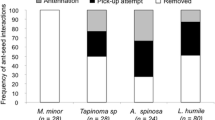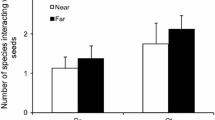Abstract
The ants Pheidole minutula and Crematogaster sp. are obligate inhabitants of the ant-plant Maieta guianensis. They nest and reproduce exclusively in this and a few other Amazon melastome ant-plants. Experimental transplants of uncolonized M. guianensis seedlings to sites at different distances from established colonies of these two ant species, which are sources of founding queens, have shown that distance is an important factor affecting seedling colonization by ants. The proportion of colonized seedlings and the average number of colonizations per seedling, both by Crematogaster sp. and P. minutula, decreased as distance from established colonies increased. Seedling colonization was also affected by rainfall and fewer seedlings were colonized during the dry season, especially by P. minutula, than during the rainy season. P. minutula queens usually cooperate with each other during colony foundation, a behaviour not observed among founding queens of Crematogaster sp. Competition between these two ant species for host-plants appears to be strong as 63.6% of the seedlings colonized by Crematogaster sp. were also colonized by P. minutula during a 15-month observational period. However, there was generally an interval of a few months between colonizations, possibly giving the first species to colonize the plant a better chance of domination on this plant.
Similar content being viewed by others
References
Adams ES (1990) Boundary disputes in the territorial ant Azteca trigona: effects of asymmetries in colony size Anim Behav 39:321–328
Bartz SE, Hölldobler B (1982) Colony founding in Myrmecocystus mimicus Wheeler (Hymenoptera: Formicidae) and the evolution of foundress associations. Behav Ecol Sociobiol 10:137–147
Benson WW (1985) Amazon ant-plants. In: Prance GT, Lovejoy TE (eds) Amazonia. Pergamon Press, Oxford, pp 239–266
Davidson DW, Snelling RR, Longino JT (1989) Competition among ants for myrmecophytes and the significance of plant trichomes. Biotropica 21:64–73
Davidson DW, Foster RB, Snelling RR, Lozada PW (1990) Variable composition of some tropical ant-plant symbioses. In: Price PW, Lewinson TM, Wilson Fernandes O, Benson WW (eds) Plant-animal interactions: evolutionary ecology in tropical and temperate regions. John Wiley, New York, pp 145–162
Hölldobler B, Wilson EO (1977) The number of queens: an important trait in ant evolution. Naturwissenschaften 64:8–15
Janzen DH (1975) Pseudomyrmex nigropilosa: a parasite of a mutualism. Science 188:936–937
Longino JT (1989) Geographic variation and community structure in an ant-plant mutualism; Azteca and Cecropia in Costa Rica. Biotropica 21:126–132
McKey D (1984) Interaction of the ant-plant Leonardoxa africana (Caesalpinaceae) with its obligate inhabitants in a rainfores in Cameroon. Biotropica 16:81–99
McKey D (1988) Promising new directions in the study of ant-plant mutualisms. In: Grenter W, Zimmer B (eds) Proceedings of the XIV International Botanical Congress Koeltz, Konigstein/Taunus, Germany, pp 335–355
Schupp EW (1986) Azteca protection of Cecropia: ant ocupation benefits juvenile trees. Oecologia 70:379–385
Tschinkel WR, Howard DF (1983) Colony founding by pleometrosis in the fire ant, Solenopsis invicta. Behav Ecol Sociobiol 12:103–113
Vasconcelos HL (1991) Mutualism between Maieta guianensis, a myrmecophytic melastome, and one of its ant inhabitants: Ant protection against insect herbivores. Oecologia 87:295–298
Wallof N (1957) The effect of the number of queens of the ant Lasius flavus (Fab.) on their survival and the rate of development of the first brood. Insectes Soc 4:391–408
Author information
Authors and Affiliations
Rights and permissions
About this article
Cite this article
Vasconcelos, H.L. Ant colonization of Maieta guianensis seedlings, an Amazon ant-plant. Oecologia 95, 439–443 (1993). https://doi.org/10.1007/BF00321000
Received:
Accepted:
Issue Date:
DOI: https://doi.org/10.1007/BF00321000




